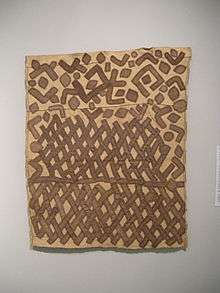Kuba textiles


Kuba textiles are unique in the Democratic Republic of the Congo, formerly Zaire, for their elaboration and complexity of design and surface decoration. Most textiles are a variation on rectangular or square pieces of woven palm leaf fiber enhanced by geometric designs executed in linear embroidery and other stitches, which are cut to form pile surfaces resembling velvet. Women are responsible for transforming raffia cloth into various forms of textiles, including ceremonial skirts, ‘velvet’ tribute cloths, headdresses and basketry.
Raffia cloth
In Kuba culture, men are responsible for raffia palm cultivation and the weaving of raffia cloth.[1] Several types of raffia cloth are produced for different purposes, the most common form of which is a plain woven cloth that is used as the foundation for decorated textile production. Men produce the cloth on inclined, single-heddle looms and then use it to make their clothing and to supply foundation cloth to female members of their clan section. The cloth is coarse when it is first cut from the loom, so it is then pounded in a mortar, which softens it and renders it ready for the application of surface decoration, for which women are responsible.[2][3]
Twool
Many prestige weavings are dyed with twool, a deep red substance obtained from the heartwood of the tropical trees Pterocarpus sp. and Baphia pubescens.[4] The Kuba believe that twool is imbued with magical and protective properties. When mixed with palm oil, it creates a pomade that is applied to the face, hair and body in a ritual context. According to oral tradition, the Pende were responsible for teaching the Kuba how to weave textiles; the Pende used twool to die their prestige clothes for death rituals.[4]
"Bambala" fabrics
Early 20th Century ethnographer Emil Torday acquired the oldest group of extant textiles from the Kuba tradition from the reigning king, Kot aPe. He called these textiles "Bambala" after the ruling clan.[4] According to Joseph Cornet, these cloths were embroidered by Bushong women who were pregnant with the King's heirs for use in rituals surrounding the birth of the children.[5] They were also used as funerary regalia for noble women. The slight sculptural relief, elaborate geometric designs and technical cohesiveness of the textiles indicate that they were created by highly skilled elders. According to art historian Vanessa Drake Moraga, "That Kuba embroiderers represented textile structures in their compositions underscores both the value of weaving to the culture and the prestige attached to women art."[4]
Women's ceremonial overskirts
Kuba women traditionally wore overskirts during burial displays, but the overskirt was later adopted as part of many ceremonial ensembles worn during ritual dances, celebrations and masked performances. The wraparound skirt was secured with a belt and worn over a typically monochrome red or white embroidered skirt. These skirts exhibit a variety of design components; some skirts employ flat linear embroidery exclusively, while others employ this technique exclusive on the borders of the fabric, in which case the interior is executed with cut-pile embroidery, which lends the surface a "plush" appearance and feel.[4] In the cut-pile embroidery technique, short raffia strands are individually inserted with a needle under one or more warps or wefts of a plain-woven raffia panel, then cut close to the surface at each end to produce the raised "pile."[6] Textile weaving boasts a variety of motifs, such as guilloche interlace, which embroidery artists employed along with color, line and texture to yield varied compositions and visual effects.
Pattern and repetition: Kuba textiles as they relate to mathematics and music

Kuba textiles demonstrate a taste for interrupting the expected line; they compose through juxtapositions of sharply differing units and abrupt shifts of form.
Mathematician Donald Crowe has analyzed, in particular, the two-dimensional designs of Benin, Yoruba and Kuba arts and has shown the extent of the Africans' explorations into the formal possibilities of geometric variation.[7][8] In their art, the Kuba have developed all the geometric possibilities of repetitive variations of border patterns, and of the seventeen ways that a design can be repetitively varied on a surface, the Kuba have exploited twelve. This exploration does not mean that they confine themselves to repetitive patterning in confronting a surface to be decorated.
The character of Kuba design accords with Robert Thompson's observation that some African music and art forms are enlivened by off-beat phrasing of accents, by breaking the expected continuum of surface, by staggering and suspending the pattern.[9] In textile design, the Africans of the Kasai-Sankuru region do not project a composition as an integrated repetition of elements. Until recently, Euro-American attitudes on this point were so fixed that we called a textile design a "repeat," and expected to find a unit of identical imagery repeated over the surface. This kind of integration is not typical for African two-dimensional arts.[6]
References
- ↑ Binkley, David A; Patricia Darish (2009). Kuba. Milan: 5 Continents Edition.
- ↑ Darish, Patricia (1990). Iowa Studies in African Art. Iowa City: University of Iowa Press.
- ↑ Darish, Patricia (1989). Annette B. Weiner and Jane Schneider, ed. Cloth and Human Experience. Washington, D.C.: Smithsonian Institution Press. pp. 117–140.
- 1 2 3 4 5 Moraga, Vanessa Drake (2011). Weaving abstraction : Kuba textiles and the woven art of Central Africa. Washington, D.C.: Textile Museum. ISBN 9780874050363.
- ↑ Cornet, Joseph (1982). Art Royal Kuba. Milan.
- 1 2 Adams, Moni (1978). "Kuba Embroidered Cloth". African Arts. 12 (1).
- ↑ Crowe, Donald W. (1998). Symmetries of culture : theory and practice of plane pattern analysis (3rd printing ed.). Seattle [u.a.]: Univ. of Washington Press. ISBN 9780295970844.
- ↑ "Kuba weaving". The Philip Gould Collection. 2010-01-29. Retrieved 2016-06-03.
- ↑ Thompson, R. F. (1974). African Art in Motion. Los Angeles: University of California Press.
External links
- Kuba Cloth: Playing with Geometry, africanconservancy.org
| Wikimedia Commons has media related to Kuba textiles. |